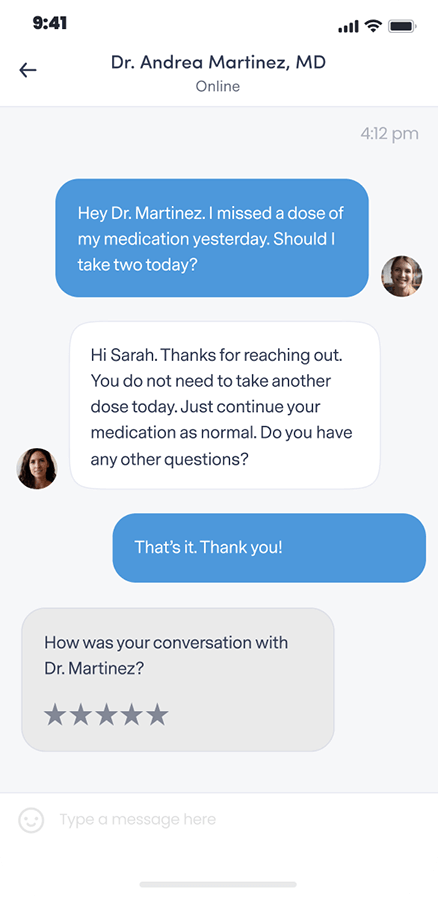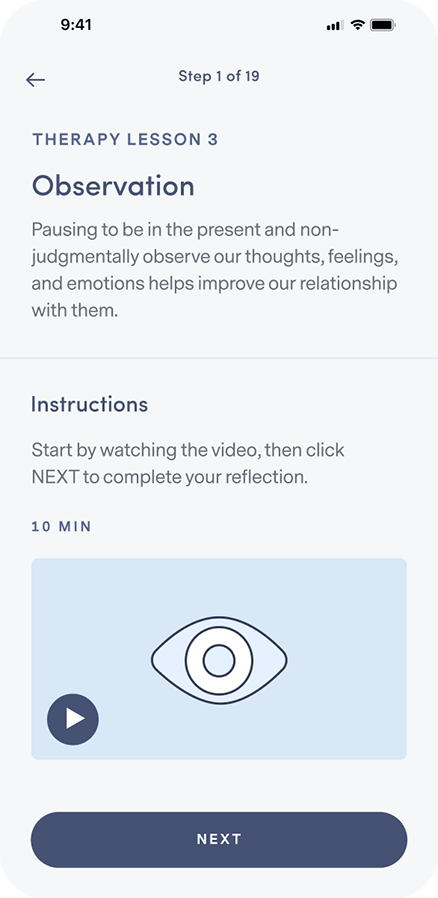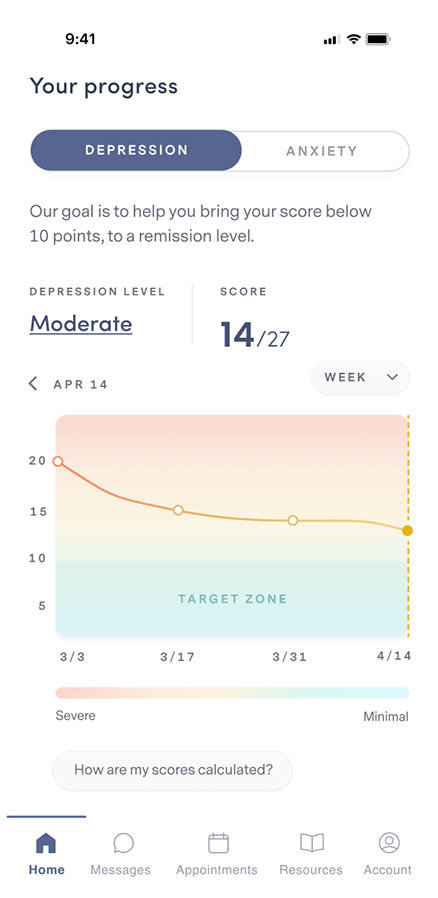HOW WE TREAT PMDD
Life-changing online care for premenstrual dysphoric disorder
Our providers understand the challenges of PMDD, and have real-world experience helping people just like you.
Start with a free assessment
HOW WE TREAT PMDD
Our providers understand the challenges of PMDD, and have real-world experience helping people just like you.
Start with a free assessment
Our Care
Different people experience PMDD in different ways. That’s why our providers work 1:1 with you to personalize treatment to your unique needs.
When medication is necessary, our psychiatric providers analyze 100+ data points to determine the most tolerable and effective prescription for you.
Our program combines cognitive and behavioral therapy with independent skill practice—all of which have been clinically proven to work for a wide range of symptoms.
Mental Health condition
In the weeks leading up to a person’s period, PMS may cause bloating, cramps, breast tenderness, and headaches. Those with PMDD may experience these symptoms as well as more severe mood changes including anxiety, depression, and irritability.

Premenstrual dysphoric disorder is similar to premenstrual syndrome (PMS), but with more severe symptoms that classify it as a mood disorder. About 6 million women worldwide have a diagnosis of PMDD.
If you’ve been diagnosed with PMDD, or think you might be experiencing symptoms of the condition, Brightside Health providers can help. With virtual mental health care, you can get started with the right treatment for your needs from the comfort of home.

PMDD symptoms may include the above, as well as:
Mental health care can help you manage PMDD symptoms and find relief.
HOW IT WORKS

Let your provider know how you’re feeling, get to know you, and provide 1:1 support.

Get questions or concerns off your chest between video visits by messaging your provider at any time.

Learn how to integrate new thought and behavior patterns into your daily life.

Complete weekly check-ins so your provider can track your progress and, if necessary, adjust your treatment and/or medication.
Our plan options
Because quality mental health care shouldn’t be out of reach for anyone.
PERSONALIZED
clinically-proven
comprehensive
Free Assessment
86% of our members feel better within 12 weeks.
We accept insurance.





FREQUENTLY ASKED QUESTIONS
If your question isn’t answered below, view our full list of FAQs here.
Brightside is available to people 18 years and older in the states where Brightside operates who believe they may be experiencing depression and may benefit from treatment.
Remote care is not a good fit for people with certain conditions or situations. These include (but are not limited to):
Our providers do not treat, and do not prescribe for adhd.
If any of these describe you, it’s best for you to be seen by a provider in person so you can get the care that’s right for you.
Brightside makes it easy to get top quality depression care from the privacy of home.
Here’s how Psychiatry works:
Here’s how Therapy works:
When scheduling your first appointment, you can browse all of our available providers in your state. Take a look at their profiles and check open times to find the best fit for you. Every Brightside provider undergoes a rigorous hiring and vetting process to ensure the highest quality care.
Brightside currently accepts select insurance plans in various states for payment of your provider’s or therapist’s services. Please see below for a current listing of plans. Brightside may not be included in all plans that each health insurance company offers. Please contact your health insurance plan to verify that your care at Brightside will be covered.
We currently accept the following insurance plans:
If you are a new member signing up for services you can enter your insurance information during the sign-up process. We’ll let you know your eligibility, as well as you estimated co-pays and out-of-pocket costs (if any) before signing-up or scheduling.
We also accept HSA/FSA payment if you have one of those accounts. If you have questions about using your medical or prescription insurance benefits, please contact us by emailing [email protected].
To diagnose PMDD, your mental health provider will ask you some questions about your symptoms. They’ll also learn about your family and medical history. People with PMDD typically have symptoms in the weeks leading up to their period, and the symptoms resolve within the first few days of menstruation. Because of this pattern, your provider may ask you to keep a tracker or diary of your symptoms before diagnosis.
At Brightside Health, your mental health provider will provide a comprehensive evaluation before diagnosis. If you already have a diagnosis, that’s fine too. Your provider will listen to your concerns and recommend a treatment plan tailored to your needs so you can start feeling better.
While there is no known cause, research suggests that changes in hormonal and serotonin levels may have a role in the development of PMDD. Both hormone levels and serotonin levels change throughout the menstrual cycle—which is believed to trigger symptoms in some people. Many women with PMDD also have underlying anxiety and depression.
If you have any of the symptoms listed above, or have been diagnosed with premenstrual dysphoric disorder, it’s a good idea to talk to a licensed mental health professional about treatment options.
PMDD symptoms can be serious if left untreated. If you are in crisis or having suicidal thoughts, call 988 for the Suicide & Crisis Lifeline or 911 for emergency services. Know that you’re not alone. With the right treatment, you can live your life with relief from symptoms.
If you’re experiencing PMDD, mental health care can help you start feeling like yourself again. Medication, therapy, and lifestyle changes are effective treatments for premenstrual dysphoric disorder. Typically, a combination of all three is most effective.
Medication
Antidepressants such as selective serotonin reuptake inhibitors (SSRIs) are effective at treating symptoms of PMDD. The Food and Drug Administration (FDA) has approved three medications to treat PMDD:
With Brightside Health, you can get medication delivered to your door monthly. Your psychiatric provider can find the right medication to treat your unique PMDD symptoms by using our PrecisionRx tool to analyze 100 data points and over 1,000 different medication combinations. Within 12 weeks, 86% of Brightside members feel better and 70% achieve remission of their symptoms altogether.
Like treatment for PMS, over-the-counter pain relievers such as ibuprofen and aspirin, and birth control can also help relieve symptoms.
Therapy
In order to be diagnosed with PMDD, you must be experiencing either a depressed mood, anxiety, emotional ups-and-downs, or irritability during your premenstrual phase. In fact, 64% of women with major depressive disorder report that their symptoms of depression worsen in the days leading up to their menstruation. Talking to a licensed therapist one-on-one can help you learn about how your thoughts, behaviors, and emotions interact so you can start feeling better.
At Brightside Health, therapy includes virtual sessions with your expert therapist, unlimited messaging, video lessons, and skill practice with reflection. Together, you and your therapist can work on effective coping strategies to help you get back to being you.
Lifestyle changes
Making a few lifestyle changes can help reduce your PMDD symptoms. By limiting your caffeine and alcohol intake; eating less salty, fatty, or sugary foods; and exercising regularly, you can improve your mood and start feeling better.
Practicing mindfulness, breathing techniques, and meditation can also help you manage stress and improve your mental health.